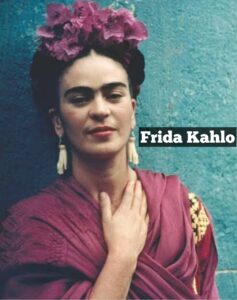Frida Kahlo: The Art of Resilience
Frida Kahlo, born Magdalena Carmen Frida Kahlo y Calderón on July 6, 1907, in Coyoacán, Mexico, is one of the most iconic and influential artists of the 20th century. Her work, characterized by its vivid colors and deeply personal themes, has left an indelible mark on the art world and continues to inspire millions.
Kahlo’s early life was marked by significant health challenges. At the age of six, she contracted polio, which left her with a limp. This early encounter with illness was a precursor to the more severe physical trauma she would endure later in life. In 1925, at the age of 18, Kahlo was involved in a catastrophic bus accident that resulted in multiple fractures to her spine, pelvis, and other parts of her body. This accident left her in chronic pain and required numerous surgeries throughout her life. During her long recovery, Kahlo began to paint, using art as a means of coping with her pain and expressing her inner world.
Kahlo’s paintings are renowned for their raw emotional intensity and symbolic content. She often depicted her own suffering and physical pain, creating a series of self-portraits that are both haunting and beautiful. Her work blends elements of realism and fantasy, often incorporating symbolic imagery that reflects her Mexican heritage and personal experiences. One of her most famous paintings, “The Two Fridas” (1939), depicts two versions of herself sitting side by side, holding hands, with their hearts exposed. This painting is often interpreted as a representation of her dual heritage and the emotional turmoil she experienced during her tumultuous marriage to the famous Mexican muralist Diego Rivera.
ALSO SEE: Linda Mcmahon Biography
Kahlo and Rivera’s relationship was complex and deeply influential on her work. They married in 1929, and their union was marked by passionate love, infidelity, and mutual artistic influence. Despite their personal struggles, Rivera recognized Kahlo’s talent and encouraged her to pursue her art. Kahlo’s work gained international recognition during her lifetime, and she became the first 20th-century Mexican artist to have a painting acquired by the Louvre in Paris.
In addition to her artistic achievements, Kahlo is celebrated as a feminist icon and a symbol of resilience. Her unapologetic exploration of themes such as identity, gender, and postcolonialism has made her a powerful figure in feminist and LGBTQ+ movements. Kahlo’s distinctive style, characterized by her bold use of color and striking self-portraits, has also made her a fashion icon.
Kahlo’s legacy continues to grow, with her childhood home, La Casa Azul, now serving as the Frida Kahlo Museum in Mexico City. The museum attracts thousands of visitors each year, eager to learn more about the life and work of this extraordinary artist. Through her art, Frida Kahlo has left a lasting legacy that transcends cultural and temporal boundaries, inspiring new generations to explore their own identities and embrace their unique experiences.
Frida Kahlo Museum
The Frida Kahlo Museum, also known as La Casa Azul (The Blue House), is located in Coyoacán, Mexico City. This museum was Kahlo’s childhood home and later the residence she shared with Diego Rivera. It houses a vast collection of her personal belongings, artworks, and artifacts, offering a glimpse into her life and creative process. The museum attracts thousands of visitors each year, celebrating Kahlo’s legacy and influence.
ALSO SEE: Pam Bondi Biography
Frida Kahlo Movie
The 2002 biographical film “Frida,” directed by Julie Taymor, stars Salma Hayek as Frida Kahlo and Alfred Molina as Diego Rivera. The film portrays Kahlo’s life, her tumultuous relationship with Rivera, and her artistic journey. It received critical acclaim and won two Academy Awards for Best Makeup and Best Original Score. The movie is based on the biography “Frida: A Biography of Frida Kahlo” by Hayden Herrera.
Frida Kahlo Artworks
Frida Kahlo’s artworks are renowned for their vivid colors and emotional intensity. Some of her most famous paintings include:
- The Two Fridas (1939) – This double self-portrait depicts two versions of Kahlo sitting side by side, holding hands, with their hearts exposed.
- Self-Portrait with Thorn Necklace and Hummingbird (1940) – A self-portrait where Kahlo wears a thorn necklace with a dead hummingbird hanging from it.
- The Broken Column (1944) – This painting shows Kahlo’s spine as a broken column, symbolizing her physical pain.
- Self-Portrait with Cropped Hair (1940) – Kahlo painted herself with short hair and wearing a suit, challenging traditional gender roles.
- The Wounded Deer (1946) – Depicts Kahlo as a deer pierced by arrows, reflecting her suffering and resilience.
- Henry Ford Hospital (1932) – This work portrays Kahlo’s miscarriage and her emotional and physical pain.
- Self-Portrait on the Borderline Between Mexico and the United States (1932) – Kahlo stands between the industrialized U.S. and the traditional Mexican landscape.
- My Birth (1932) – A raw depiction of childbirth, reflecting Kahlo’s complex feelings about motherhood.
- What the Water Gave Me (1938) – A surreal painting showing various scenes from Kahlo’s life in a bathtub.
- Self-Portrait with Monkey (1938) – Kahlo is depicted with a monkey, symbolizing her love for animals and her Mexican heritage.
These artworks are celebrated for their emotional depth, vivid colors, and symbolic content, making Frida Kahlo one of the most influential artists of the 20th century.
Frida Kahlo Husband
Diego Rivera, a prominent Mexican muralist, was Frida Kahlo’s husband. They married in 1929, divorced in 1939, and remarried in 1940. Their relationship was marked by passion, infidelity, and mutual artistic influence. Rivera’s encouragement and recognition of Kahlo’s talent played a significant role in her artistic development. Despite their tumultuous marriage, they remained deeply connected until Kahlo’s death in 1954.





![Mercy Sunot - The Voice that Defined an Era [ Life | Spouse | Death]](https://lifeinbiography.com.ng/wp-content/uploads/2024/12/mercy-sunot-aegis-singer-dies.jpg)

